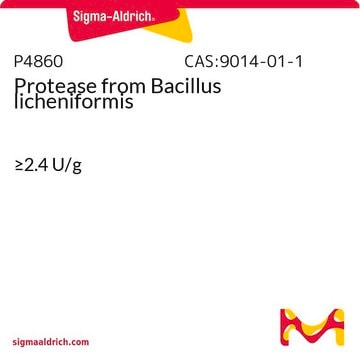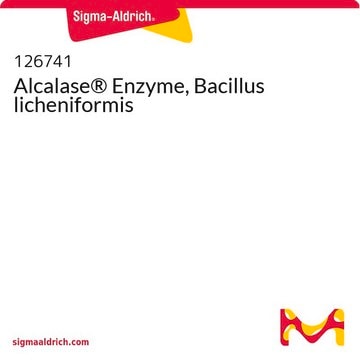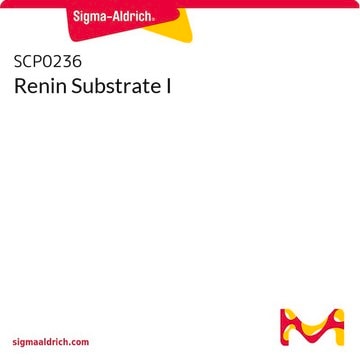R4877
Rennin from calf stomach
≥20 units/mg protein
Synonym(s):
Chymosin
Sign Into View Organizational & Contract Pricing
All Photos(1)
About This Item
Recommended Products
form
lyophilized powder
specific activity
≥20 units/mg protein
purified by
crystallization
composition
Protein, ≥40%
storage temp.
−20°C
Looking for similar products? Visit Product Comparison Guide
Related Categories
Application
Rennin, also known as chymosin, is a milkclotting acid proteinase produced in the stomach of a calf. It is used in cheesemaking and to study neonatal gastric digestion .
Biochem/physiol Actions
Rennin, a 323 amino acid chain, is secreted as an inactive precursor which is then converted into an active enzyme through limited proteolysis. It cleaves the peptide bond between phenylalanine and methionine in K-Casein.
Packaging
Package size based on protein content
Unit Definition
One unit will coagulate 10 mL of milk per min at 30 °C.
Physical form
Lyophilized powder containing sodium chloride
Analysis Note
Protein determined by biuret.
Signal Word
Danger
Hazard Statements
Precautionary Statements
Hazard Classifications
Eye Irrit. 2 - Resp. Sens. 1 - Skin Irrit. 2 - STOT SE 3
Target Organs
Respiratory system
Storage Class Code
11 - Combustible Solids
WGK
WGK 3
Certificates of Analysis (COA)
Search for Certificates of Analysis (COA) by entering the products Lot/Batch Number. Lot and Batch Numbers can be found on a product’s label following the words ‘Lot’ or ‘Batch’.
Already Own This Product?
Find documentation for the products that you have recently purchased in the Document Library.
Customers Also Viewed
Jung-Feng Hsieh et al.
Journal of agricultural and food chemistry, 60(8), 2039-2045 (2012-02-07)
Chymosin-induced coagulation of individual milk proteins during incubation at 30 °C was investigated using a proteomic approach. The addition of chymosin (0.006 units/mL) caused the milk proteins to coagulate after a 3 h incubation period. Approximately 88% of the milk
X P Jiang et al.
World journal of microbiology & biotechnology, 28(5), 2087-2093 (2012-07-19)
Chymosin can specifically break down the Phe105-Met106 peptide bond of milk κ-casein to form insoluble para-κ-casein, resulting in milk coagulation, a process that is used in making cheese. In this study, in order to obtain an alternative milk coagulant which
Filiz Kazak et al.
Veterinary research forum : an international quarterly journal, 13(4), 593-596 (2023-01-24)
Epidermal growth factor (EGF) has biological roles, including embryonic organ development, breast morphogenesis, breast cell proliferation, and mammary development. This study aimed to measure EGF concentration and evaluate its relationship with somatic cell count (SCC) in healthy water buffaloes (Bubalus
J A Vallejo et al.
Journal of dairy science, 95(2), 609-613 (2012-01-28)
The first step in cheesemaking is the milk clotting process, in which κ-caseinolytic enzymes contribute to micelle precipitation. The best enzyme for this purpose is chymosin because of its high degree of specificity toward κ-casein. Although recombinant bovine chymosin is
Katarina Kosalková et al.
Microbial cell factories, 11, 5-5 (2012-01-12)
The secretion of heterologous animal proteins in filamentous fungi is usually limited by bottlenecks in the vesicle-mediated secretory pathway. Using the secretion of bovine chymosin in Aspergillus awamori as a model, we found a drastic increase (40 to 80-fold) in
Our team of scientists has experience in all areas of research including Life Science, Material Science, Chemical Synthesis, Chromatography, Analytical and many others.
Contact Technical Service









